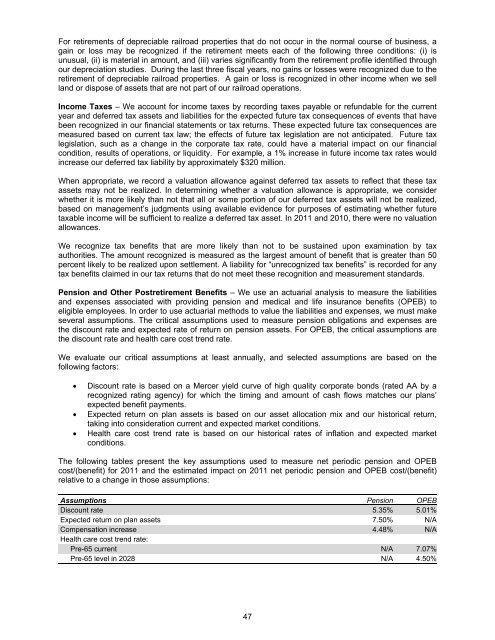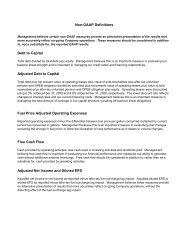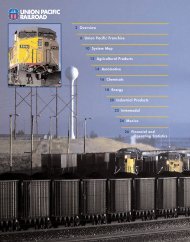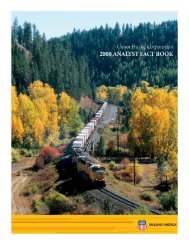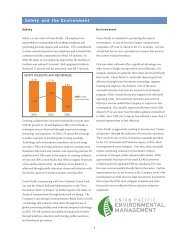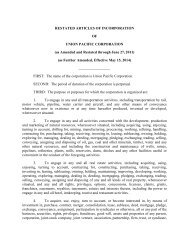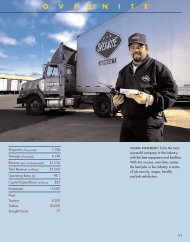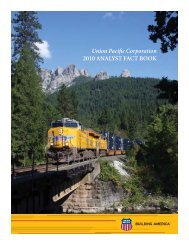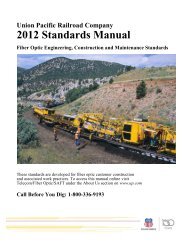Form 10-K - Union Pacific
Form 10-K - Union Pacific
Form 10-K - Union Pacific
You also want an ePaper? Increase the reach of your titles
YUMPU automatically turns print PDFs into web optimized ePapers that Google loves.
For retirements of depreciable railroad properties that do not occur in the normal course of business, a<br />
gain or loss may be recognized if the retirement meets each of the following three conditions: (i) is<br />
unusual, (ii) is material in amount, and (iii) varies significantly from the retirement profile identified through<br />
our depreciation studies. During the last three fiscal years, no gains or losses were recognized due to the<br />
retirement of depreciable railroad properties. A gain or loss is recognized in other income when we sell<br />
land or dispose of assets that are not part of our railroad operations.<br />
Income Taxes – We account for income taxes by recording taxes payable or refundable for the current<br />
year and deferred tax assets and liabilities for the expected future tax consequences of events that have<br />
been recognized in our financial statements or tax returns. These expected future tax consequences are<br />
measured based on current tax law; the effects of future tax legislation are not anticipated. Future tax<br />
legislation, such as a change in the corporate tax rate, could have a material impact on our financial<br />
condition, results of operations, or liquidity. For example, a 1% increase in future income tax rates would<br />
increase our deferred tax liability by approximately $320 million.<br />
When appropriate, we record a valuation allowance against deferred tax assets to reflect that these tax<br />
assets may not be realized. In determining whether a valuation allowance is appropriate, we consider<br />
whether it is more likely than not that all or some portion of our deferred tax assets will not be realized,<br />
based on management’s judgments using available evidence for purposes of estimating whether future<br />
taxable income will be sufficient to realize a deferred tax asset. In 2011 and 20<strong>10</strong>, there were no valuation<br />
allowances.<br />
We recognize tax benefits that are more likely than not to be sustained upon examination by tax<br />
authorities. The amount recognized is measured as the largest amount of benefit that is greater than 50<br />
percent likely to be realized upon settlement. A liability for “unrecognized tax benefits” is recorded for any<br />
tax benefits claimed in our tax returns that do not meet these recognition and measurement standards.<br />
Pension and Other Postretirement Benefits – We use an actuarial analysis to measure the liabilities<br />
and expenses associated with providing pension and medical and life insurance benefits (OPEB) to<br />
eligible employees. In order to use actuarial methods to value the liabilities and expenses, we must make<br />
several assumptions. The critical assumptions used to measure pension obligations and expenses are<br />
the discount rate and expected rate of return on pension assets. For OPEB, the critical assumptions are<br />
the discount rate and health care cost trend rate.<br />
We evaluate our critical assumptions at least annually, and selected assumptions are based on the<br />
following factors:<br />
<br />
<br />
<br />
Discount rate is based on a Mercer yield curve of high quality corporate bonds (rated AA by a<br />
recognized rating agency) for which the timing and amount of cash flows matches our plans’<br />
expected benefit payments.<br />
Expected return on plan assets is based on our asset allocation mix and our historical return,<br />
taking into consideration current and expected market conditions.<br />
Health care cost trend rate is based on our historical rates of inflation and expected market<br />
conditions.<br />
The following tables present the key assumptions used to measure net periodic pension and OPEB<br />
cost/(benefit) for 2011 and the estimated impact on 2011 net periodic pension and OPEB cost/(benefit)<br />
relative to a change in those assumptions:<br />
Assumptions Pension OPEB<br />
Discount rate 5.35% 5.01%<br />
Expected return on plan assets 7.50% N/A<br />
Compensation increase 4.48% N/A<br />
Health care cost trend rate:<br />
Pre-65 current N/A 7.07%<br />
Pre-65 level in 2028 N/A 4.50%<br />
47


